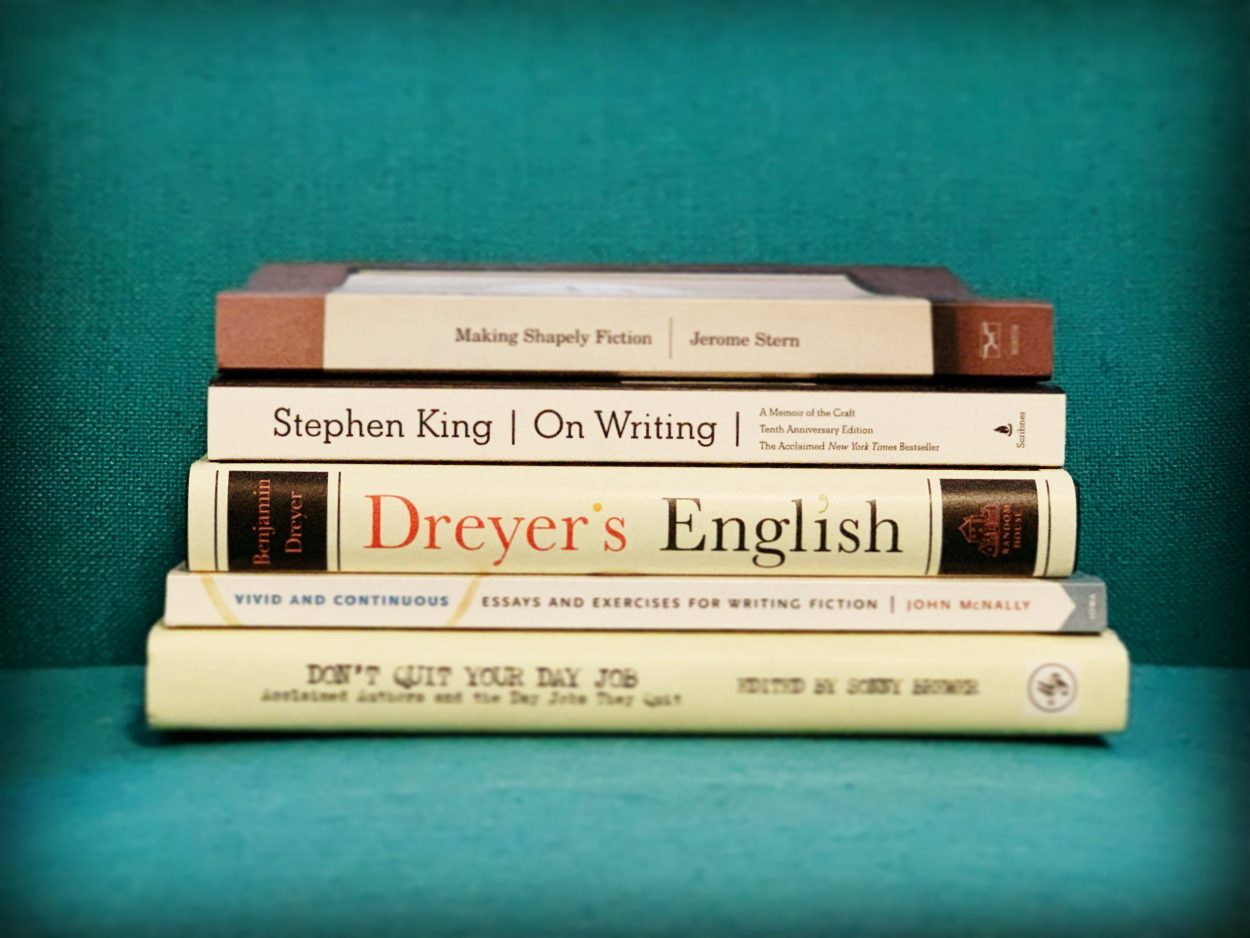Here in no particular order are five of my favorite books on the writing craft and the writing life:
Making Shapely Fiction by Jerome Stern
I love the structure of this book, as well as its wisdom. The book is organized into four sections which are fairly self-explanatory:
- The Shape of Fiction. This section is a guide to the various forms a story can take.
- A Cautionary Interlude. This section consists of two subsections: Write What You Know and Don’t Do This: A Short Guide to What Not to Do.
- From Accuracy to Zigzag: An Alphabet for Writers of Fiction. This section is an encyclopedia of literary terms and devices, such as point of view, voice, and narrator. It’s more detailed than a glossary, providing subterms and examples.
- Readables: Where to Learn More. This is a great resource listing some of the better craft books.
“Reading about writing isn’t writing…. [N]o book on fishing will bring home a trout, and no book on fiction will write your story.” –Jerome Stern, Making Shapely Fiction
On Writing: A Memoir of the Craft by Stephen King
This book offers a little bit of everything for writers. Stephen King provides suggestions that will improve your writing, but he also inspires and motivates. He shares the story of his writing career, the beginnings of which may not be too unlike your own. He also shares what writing means to him.
The book is structured in the following sections:
- C.V. In this section, King details his life and journey as a writer. I don’t know about you, but I always find it inspiring to read about someone who succeeded at the things I want to succeed at and to learn they had beginnings as humble and faced challenges as difficult as my own.
- Toolbox. In this section, King discusses the tools all writers need to have available to them.
- On Writing. Here, King discusses the craft of writing and offers tips based on his own experiences.
- On Living: A Postscript. In this section, King writes about the accident that nearly took his life a little over 20 years ago and the happiness he found when he returned to writing during his recovery.
- And Furthermore, Part I: Door Shut, Door Open. This section offers a glimpse into King’s revision/rewriting process.
- And Furthermore, Part II: A Booklist. A list of about 100 of King’s favorite books as of On Writing‘s publication in 2000.
- And Furthermore, Part III. An updated list of about 80 more books that became King’s favorites in the ensuing 10 years, before the 2010 edition was published.
“[Y]ou can, you should, and if you’re brave enough to start, you will. Writing is magic, as much the water of life as any other creative art. The water is free. So drink.” –Stephen King, On Writing
Vivid and Continuous: Essays and Exercises for Writing Fiction by John McNalley
This relatively thin 147-page book may be my favorite book on the craft of writing. It’s basic in the best way–it’s written simply, it’s engaging, and it covers the topics many of us have questions about when we start writing, things like, What makes a good story? What makes a good beginning? How do we create tension? What should our title be?
Each section of the book has exercises at the end, and the book concludes with a list of recommended reading organized by category: books cited in Vivid and Continuous, books on the writing craft, books on the writing life, and some of the author’s favorites. This book could easily be read in one or two sittings, and readers will come away having learned concrete ways to improve their writing, like this:
“Whenever possible, crunch time. If you have an idea for a short story that takes place over many years, ask yourself if it will work over the course of a month or a week. If it takes place over a week, can it happen in a day? If it takes place over twenty-four hours, would it work having it take place over an hour? Crunching time is one of the most effective ways to make a piece of prose more immediate.”
–John McNally, Vivid and Continuous
Dreyer’s English: An Utterly Correct Guide to Clarity and Style by Benjamin Dreyer
This book should be on your bookshelf.
I’m currently taking a year-long copyediting course. Last weekend, I read 80 pages on punctuation and hyphens. The night before last, I read 25 pages on numbers. I share this to let you know that English grammar can be a slog.
This is why you will appreciate Dreyer’s English–this beautiful little book is a much more enjoyable option for those who want to brush up on the basics and polish their writing until it shines. The author, Benjamin Dreyer, is the copy chief at Random House, one of the “Big 5” publishing houses. He writes with charm and wit and offers often humorous examples throughout the book. He delves into the rules, to be sure, but he also addresses “nonrules”–traditional rules that are unhelpful to creative writers. Some of my favorites of his observations have to do with writing habits that may be grammatically correct, but are annoying and make writing dull.
“A good sentence, I find myself saying frequently, is one that the reader can follow from beginning to end, no matter how long it is, without having to double back in confusion because the writer misused or omitted a key piece of punctuation, chose a vague or misleading pronoun, or in some other way engaged in inadvertent misdirection.” –Benjamin Dreyer, Dreyer’s English
Don’t Quit Your Day Job: Acclaimed Authors and the Day Jobs They Quit edited by Sonny Brewer
This last one is for fun, but it’s for motivation, too. This is an anthology–authors writing about the day jobs they once had and quit. The short pieces have titles like “Tote Monkey” (Joshilyn Jackson, Mother May I; Never Have I Ever); “My Shit Job” (Daniel Wallace, Big Fish: A Novel of Mythic Proportions); “Connie May is Going to Win the Lottery this Week” (Connie May Fowler, Before Women Had Wings; A Million Fragile Bones); and “Why I Worked at the P.O.” (Silas House, Southernmost).
As an emerging writer, it gives me great comfort to know that John Grisham once sold underwear at Sears and that Winston Groom sold encyclopedias and didn’t publish Forrest Gump until he was 43.
I’ll share my favorite: Joshilyn Jackson writes about an office job which she thought would be right up her alley: “The first thing I thought of was Jennifer on WKRP in Cincinnati, laughingly refusing to do everything her boss asks.” Jackson puts her talent for storytelling to work–she makes up a fake boyfriend named Dan to cover for the fact she spends her weekends at home alone, writing and drinking beer. It backfires when the lack of details in her story lead her coworkers to conclude that Dan is married and that Jackson can do better.
“I liked how they all rallied around me and took my side. I began to slant the Dan stories. He cancelled on me a lot at the last minute. He bought me a gym membership for my birthday because he said I was ‘pushing maximum density’–a line I stole directly from The Breakfast Club. He promised to join me at the office Christmas party, but he never showed. I paged him several times, to no avail, then crept theatrically away to pretend to cry in the bathroom.”–Joshilyn Jackson, “Tote Monkey,” Don’t Quit Your Day Job
One last observation: There are some good craft books out there, but if you want to become a better writer, the best two things you can do are (1) write consistently; and (2) become a voracious reader of all kinds of books. Read well–choose excellent, well-written books, contemporary novels and classics, best-sellers and indie gems, critically acclaimed books and books that are recommended by trusted friends. And read widely. Yes, read in the genre in which you are writing, but read outside your genre as well. You will learn a lot.

